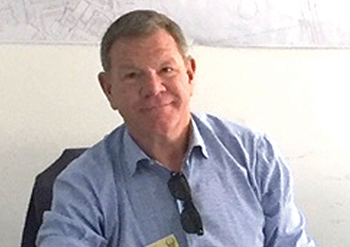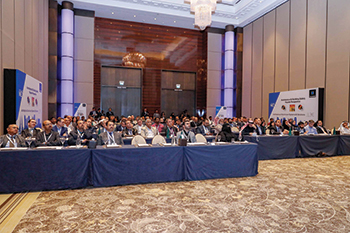Stopping fires in their tracks
The internal and external design of buildings, and the use of code-compliant materials are key areas that need to be addressed to prevent the spread of fire in buildings, writes ABDULAZIZ KHATTAK.
01 March 2019
The spandrel area, a seemingly inconsequential space in a building, matters hugely in building design especially considering its relevance to the protection of life and property in the event of a fire.
Fire-related tragedies around the globe, some as recently as the Grenfell Tower in London where 72 people lost their lives, not only reiterate the need to use code-compliant materials, but the adoption of best practices in building design, especially the outer envelope.
These were the views echoed by Adrian Brown*, a specialist consultant in fire safety from the UK, who spoke on ‘A Global Perspective for the Control of Fire Development across Façade Systems’ at the ‘World of Technal’ technical and architectural educational conference series held by Technal Middle East (TME) in Bahrain last month.
 |
|
Brown ... use of code-compliant materials stressed. |
Citing several examples of fierce fires in buildings from around the world, he stressed highly flammable cladding systems had been the root cause for the rapid spread of fire. The Grenfell Tower is one example.
Back in 1991, the 38-storey One Meridian Plaza in Philadelphia, the US, caught fire at the 22nd floor that spread to the 30th. Three fire-fighters died in the fire that was attributed to have spread because of leap-frogging, sprinklers not working, delayed fire calls, absence of internal compartmentalisation and inadequate water supplies.
Highly flammable cladding was the cause of the rapid fire spread on New Year’s Eve 2016 at the 63-storey Address Hotel in Dubai, he said. In fact, the fire here spread at a speed of 1 m per second (3.6 kmph).
But it’s not always cladding that may be blamed for the fire spread. In a fire that occurred in a traditionally built New York building, the flames again exhibited the leapfrogging effect, except this time, there was no cladding present at all. However, a noticeable aspect was the size of the windows: they were small.
Brown said the smaller the windows, the farther the flames will come out of the building through a phenomenon called the coanda effect, where the flames are pushed back against the building.
Brown said engineers needed to focus on the external envelopes of buildings from a fire engineering perspective, and windows are part of that focus.
Building envelopes can be façades or cladding systems, solid stone-faced traditional types, or glazed curtain-walls, Brown said, adding the latter have a lot of issues when it comes to fire safety design.
Going back to the basics, he said, when a fire starts inside a building compartment, the flames first move to the ceiling and then outwards until they hit a vertical barrier. From there, they travel upwards through the phenomenon called leapfrogging (also called autoexposure in the US).
The spandrel
The spandrel is a very important part of the building and plays a huge role in preventing fire spread. The space between the slab and the spandrel panel is one way for the fire to penetrate, giving rise to an internal vertical fire that spreads inside the curtain-wall itself. Therefore, it’s important to get the design right.
Brown said the spandrel (and the shadow-box area) is one of the most dynamic but passive systems in a building. A shadowbox consists of clear or opaque glazing with a cavity behind the glazing or an insulated panel or tray.
At this point, Brown said, there has to be some sort of flexibility in design between the curtain-wall and the glazed elements and the floor slab.
Most fire codes and certainly the UAE fire code require a spandrel to be “not less than 915 mm high or a wall with a one-hour fire-resistance rating, or between the openings with a 760-mm horizontally projecting barrier with a one-hour fire-resistance rating”.
“The whole point of that is to prevent the thickest part of the flames which give the most radiation and aid in fire spread,” Brown said.
Heat radiation ignites any combustible material and causes flashover – a phenomenon, where the temperature and heat flux from combustible items on fire hits around 600 deg C.
Luckily, in this part of the world, he said the sprinkler system is mandated into the building design and this controls the fire development, thus preventing the gas from breaking and leaping outside on the external envelope.
Brown said it is important that the fire is controlled internally, because it could leap outside the building and spread to the external envelope.
In this regard, TME has successfully tested (EN-1364-4) a solution utilising a non-fire-rated curtain-wall assembly, which features perimeter fire protection from SideRise.
The solution provides a firestop at the gap between the edge of the slabs and back of the glazed aluminium curtain-wall.
The assembly used the SideRise fire board (FB) on the back of the spandrel area to protect this zone. In the event of a fire breakout, the fire passes from the spandrel zone, where the flame will act on the aluminium glazed panels above the slab, and might even pass through this zone. The solution passed tests for insulation and integrity to EI 120 (two-hour fire integrity).
Any standard non-fire-rated curtain-wall from the Technal Geode range can incorporate SideRise’s perimeter fire protection.
The UAE fire code, however, allows three exemptions from having the fire-rated spandrel. These include availability of a sprinkler system, if the building is low-rise, and if the spandrel is not inside a car-park.
But apart from these, the use of fire resistance material was mandatory. Even in a zero spandrel system, which might get through the ASTM E2307 fire test, a 90-minute fire resistance has to be provided, considering there were no exemptions, Brown concluded.
* Adrian Brown is a fire service advisor with the Dubai Civil Defence. Prior to arriving in Dubai, he spent 38 years with the UK Fire and Rescue Service, the last four of which as the director of the fire engineering and fire investigation courses at the UK Fire Service College.
Brown is a chartered fire engineer, a forensic fire investigator with the International Association of Arson Investigators, a police officer with Thames Valley Police and also sits on the editorial board with BSI committee FH14 for British standards 9999, 9991 and 7974.
- Stopping fires in their tracks
- Walki membrane passes fire test
- New Hormann facility rolls out fire-rated doors



